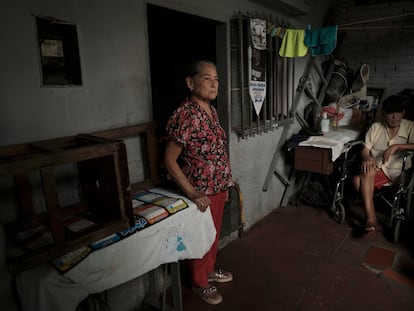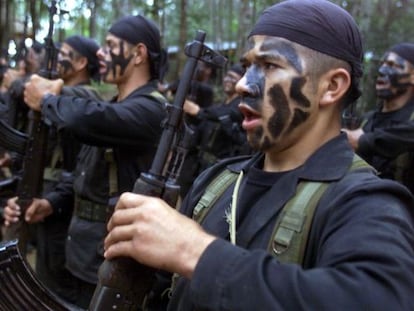Colombia comes to grips with horror of crematoriums, used by paramilitary groups to dispose of bodies
Former paramilitary chief Salvatore Mancuso has assured Colombian authorities that the remains of hundreds of bodies – disappeared during the country’s internal armed conflict – can be found along the border with Venezuela
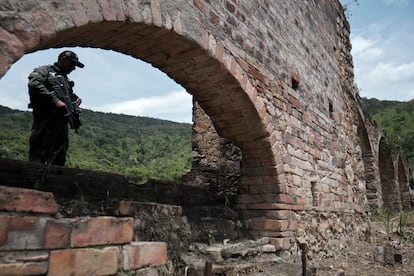

Colombia is trying to overcome one of the most atrocious chapters in its decades-long armed conflict. This past Tuesday, the ruins of a crematorium were found in Juan Frío, in the north of the region of Santander. A rural area near the Táchira river, it is one of the markers of the porous border with Venezuela. Paramilitary groups used crematoriums such as these to disappear the bodies of their victims at the height of the war.
“We see this act as one more in the search for total peace,” Foreign Minister Álvaro Leyva solemnly declared, at an event that brought together people whose relatives were forcibly disappeared during Colombia’s armed conflict. Former paramilitary chief Salvatore Mancuso sent a recorded message from a US penitentiary. The jailed warlord has assured Colombia’s authorities that the remains of hundreds of disappeared people are still buried in mass graves on the Venezuelan side of the border.
The border community of Juan Frío has suffered unspeakably in the past decades, since the arrival of the Catatumbo Bloc – of the so-called United Self-Defense Forces of Colombia (AUC) – which sought to remove FARC and ELN insurgents from the area.
“Our society… made us feel despised [because we had to] live near these groups and people,” laments Fidedigna Gómez, one of the victims who spoke at the event to highlight the resilience of her fellow community members. “This stigma [caused by the paramilitaries and insurgents]... affected us at work, psychologically, economically and culturally. Fear, sadness, aggression, depression, paranoia, anxiety and death itself are still around.”
Gómez is looking for her father, who’s been missing for more than 20 years. She remembers that, when the crematorium was functioning, it emanated the smell of sugar cane honey, before turning into a stench of charred meat. “What the river took away, what the dogs ate… who is going to answer for this?” she wonders.
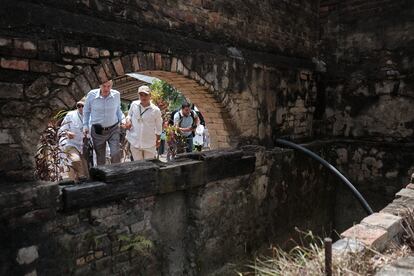
“Those who saw [the killings] and suffered [through the period of violence] say that the dismembered corpses of neighbors and strangers flowed down the rivers. Some were even still alive,” says Helena Urán Bidegain, an advisor to Colombia’s Ministry of Foreign Affairs, specializing in peace studies and reconciliation. She is also a victim of the violence: her father was magistrate Carlos Horacio Urán Rojas, who, in 1985, was tortured, killed and disappeared by Colombian soldiers during their attempt to retake the Palace of Justice, which was seized by M-19 guerrillas.
“The methods [along the border] became systematic and increasingly inhumane… then came the crematory ovens. The river was no longer enough [for the paramilitaries]... they looked for other ways to make human beings – living and dead – disappear,” she explains.
Disappearance is one of the worst crimes of any war, as it produces a suspended state, with the families of victims left frozen in time. “Atrocities – such as mutilating bodies, throwing the remains into rivers, or burning them in crematoriums – show the extent of dehumanization and horror on a large scale,” says a passage from the final report of Colombia’s Truth Commission, which discusses how these practices were part of the training given by paramilitary groups to new recruits.
The government of Gustavo Petro has put Colombian diplomacy at the service of peace. He has advocated for the concept of “total peace,” with which he intends to implement the peace agreement with the now-extinct FARC with greater determination. He also intends to initiate dialogue with the ELN and advance the surrender of criminal groups, such as the Clan del Golfo. The Ministry of Foreign Affairs – in response to the recommendations made by the Truth Commission to prevent future violence – has assumed a commitment to victims. “This isn’t the only grave; there are many more,” Foreign Minister Leyva remarked at the memorial.
The inhabitants of border areas suffered through the decades-long war with particular intensity. The AUC arrived in Juan Frío in September 2000, where they began the practice of burning bodies, to make them disappear. Those who bear the most responsibility are members of the Catatumbo Bloc of the AUC, which was commanded by Mancuso and Jorge Iván Laverde.
In different accounts before the court system, Laverde has recounted different forms of complicity between the paramilitaries and the Colombian government. According to his version of events, the idea of using the makeshift crematoriums originated from a tip from the Prosecutor’s Office, which alerted the AUC about imminent investigations in the area. If the authorities found the bodies that they had disappeared, a scandal would have erupted. For this reason, the paramilitary units began to use brick ovens as crematoriums to erase evidence. This practice later spread to other regions of the country, as several investigations have documented.
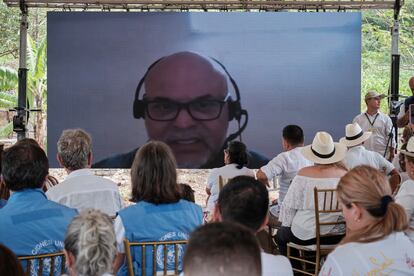
In his recorded message, Mancuso – one of the most well-known figures of the war – told the audience that more than 200 people who were disappeared by the AUC are in mass graves on the Venezuelan side of the border. He asked Foreign Minister Leyva to work with the government of Venezuela to recover the remains, offering to assist in the search. Leyva is confident that the recent reestablishment of relations with Caracas will allow this possibility to be explored.
The AUC demobilized between 2003 and 2006 after accepting the Justice and Peace process. Mancuso was subsequently extradited to the United States after being charged with drug trafficking. With that sentence now complete, he is waiting to return to Colombia, where he is accused of coordinating more than a hundred massacres. From his North American prison, he has testified before the Truth Commission and has repeatedly requested that he be allowed to submit himself to the Special Jurisdiction for Peace (JEP), claiming that his confession would reveal still-unknown links between the armed group and certain financial interests.
Starting on Wednesday, May 11, the former warlord will attend a new hearing – his last opportunity to prove to the justice system that he was a point of connection between now-defunct paramilitary groups and Colombia’s security forces. Any considerations regarding his inclusion in the JEP will depend on the significance of the contributions he makes.
Sign up for our weekly newsletter to get more English-language news coverage from EL PAÍS USA Edition
Tu suscripción se está usando en otro dispositivo
¿Quieres añadir otro usuario a tu suscripción?
Si continúas leyendo en este dispositivo, no se podrá leer en el otro.
FlechaTu suscripción se está usando en otro dispositivo y solo puedes acceder a EL PAÍS desde un dispositivo a la vez.
Si quieres compartir tu cuenta, cambia tu suscripción a la modalidad Premium, así podrás añadir otro usuario. Cada uno accederá con su propia cuenta de email, lo que os permitirá personalizar vuestra experiencia en EL PAÍS.
¿Tienes una suscripción de empresa? Accede aquí para contratar más cuentas.
En el caso de no saber quién está usando tu cuenta, te recomendamos cambiar tu contraseña aquí.
Si decides continuar compartiendo tu cuenta, este mensaje se mostrará en tu dispositivo y en el de la otra persona que está usando tu cuenta de forma indefinida, afectando a tu experiencia de lectura. Puedes consultar aquí los términos y condiciones de la suscripción digital.
More information
Archived In
Últimas noticias
Maduro pleads not guilty before the federal court in New York: ‘I am still the president of Venezuela’
A new test can detect Alzheimer’s from a finger prick
UN team enters Sudanese city of El Fasher after paramilitary massacre: ‘It’s like a ghost town’
A recipe for resistance: Indigenous peoples politicize their struggles from the kitchen
Most viewed
- Gilles Lipovetsky: ‘If you want to live better and fall in love, take Prozac, don’t look to philosophy’
- Alain Aspect, Nobel laureate in physics: ‘Einstein was so smart that he would have had to recognize quantum entanglement’
- Alvin Hellerstein, a 92-year-old judge appointed by Bill Clinton, to preside over Maduro’s trial in New York
- Why oil has been at the center of Venezuela-US conflicts for decades
- Maduro’s downfall puts China’s relationship with Venezuela to the test
